|
|
The Beginning of the Church's Year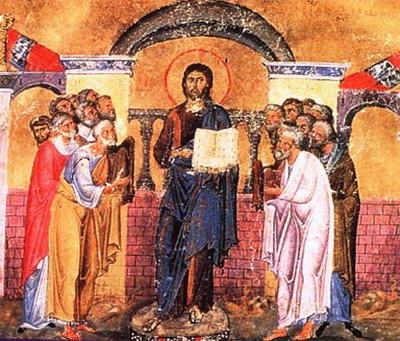 The First Ecumenical Council decreed that the Church's year should begin on September 1st. The month of September was, for the Jews, the beginning of the civil year (see Exodus 12:2), the month of the gathering of fruits and the bringing to God of sacrifices of thanksgiving. It was at the time of this feast that the Lord Jesus went into the synagogue in Nazareth, opened the Book of the Prophet Isaiah and read the words: "The Spirit of the Lord is upon Me; because He hath anointed Me to preach good tidings unto the meek; He hath sent Me to bind up the broken-hearted, to proclaim liberty to the captives, and the opening of the prison to them that are bound; to proclaim the acceptable year of the Lord, and the day of vengeance" (Is. 61:1-2; cf. Luke 4:16-21). This month of September is also noted in the history of Christianity because it was during September that Constantine the Great was victorious over Maxentius, the enemy of the Christian faith, a victory followed by the granting of freedom of confession of the Christian faith throughout the whole Roman Empire. For a long time, the civil year in the Christian world was reckoned in the same way as the Church"s year, from September 1st, but it was later changed to January 1st, first in western Europe and then also in Russia in the time of Peter the Great. The First Ecumenical Council decreed that the Church's year should begin on September 1st. The month of September was, for the Jews, the beginning of the civil year (see Exodus 12:2), the month of the gathering of fruits and the bringing to God of sacrifices of thanksgiving. It was at the time of this feast that the Lord Jesus went into the synagogue in Nazareth, opened the Book of the Prophet Isaiah and read the words: "The Spirit of the Lord is upon Me; because He hath anointed Me to preach good tidings unto the meek; He hath sent Me to bind up the broken-hearted, to proclaim liberty to the captives, and the opening of the prison to them that are bound; to proclaim the acceptable year of the Lord, and the day of vengeance" (Is. 61:1-2; cf. Luke 4:16-21). This month of September is also noted in the history of Christianity because it was during September that Constantine the Great was victorious over Maxentius, the enemy of the Christian faith, a victory followed by the granting of freedom of confession of the Christian faith throughout the whole Roman Empire. For a long time, the civil year in the Christian world was reckoned in the same way as the Church"s year, from September 1st, but it was later changed to January 1st, first in western Europe and then also in Russia in the time of Peter the Great.Our Holy Father Simeon Stylites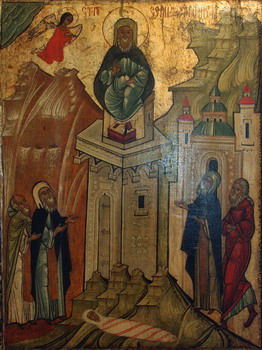 Born in Syria of peasant parents, he fled from them at the age of eighteen and became a monk. He gave himself to the strictest asceticism, sometimes fasting for forty days. After that, he followed a particular ascesis, until then unknown: standing day and night on a pillar in unceasing prayer. His pillar was at first three metres high, then one of six metres was built for him, then eleven, eighteen and finally twenty. His mother, Martha, came to see him twice, but he would not receive her, saying to her from his pillar: "Don"t disturb me now, Mother dear, if we are to be worthy to meet in the next world." St Simeon endured innumerable assaults from demons, overcoming them all by prayer. He worked great miracles, healing the sick by his prayers and his words. People from all sides gathered around his pillar: rich and poor, kings and slaves. He helped them all, restoring bodily health to some, giving comfort and instruction to others and denouncing some for their heretical faith. The Empress Eudocia was thus turned from the Eutychian heresy back to Orthodoxy. Simeon lived in asceticism during the reigns of the Emperors Theodosius the Younger, Marcian and Leo the Great. This first Christian stylite and great wonderworker, St Simeon, lived for seventy years, and entered into rest in the Lord on September 1st, 459. His relics were taken to Antioch, to the church dedicated to his name. Born in Syria of peasant parents, he fled from them at the age of eighteen and became a monk. He gave himself to the strictest asceticism, sometimes fasting for forty days. After that, he followed a particular ascesis, until then unknown: standing day and night on a pillar in unceasing prayer. His pillar was at first three metres high, then one of six metres was built for him, then eleven, eighteen and finally twenty. His mother, Martha, came to see him twice, but he would not receive her, saying to her from his pillar: "Don"t disturb me now, Mother dear, if we are to be worthy to meet in the next world." St Simeon endured innumerable assaults from demons, overcoming them all by prayer. He worked great miracles, healing the sick by his prayers and his words. People from all sides gathered around his pillar: rich and poor, kings and slaves. He helped them all, restoring bodily health to some, giving comfort and instruction to others and denouncing some for their heretical faith. The Empress Eudocia was thus turned from the Eutychian heresy back to Orthodoxy. Simeon lived in asceticism during the reigns of the Emperors Theodosius the Younger, Marcian and Leo the Great. This first Christian stylite and great wonderworker, St Simeon, lived for seventy years, and entered into rest in the Lord on September 1st, 459. His relics were taken to Antioch, to the church dedicated to his name.St Joshua the Son of Nun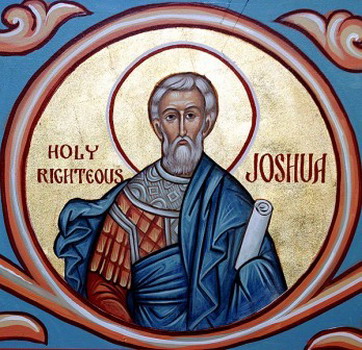 Joshua was the leader of the Jewish people after the death of Moses. Only he and Caleb, of the several hundred thousand Jews that left Egypt, entered the Promised Land. Read of his faithfulness to God, his works and his wonders in the Book of Joshua. He lived for a hundred and ten years, and died in about 1440 B.C. Joshua was the leader of the Jewish people after the death of Moses. Only he and Caleb, of the several hundred thousand Jews that left Egypt, entered the Promised Land. Read of his faithfulness to God, his works and his wonders in the Book of Joshua. He lived for a hundred and ten years, and died in about 1440 B.C.St. Martha (428) Mother of Venerable Symeon Stylites (the Elder). Mother of Venerable Symeon Stylites (the Elder).Martyrs Callista and her brothers Evodus and Hermogenes, at Nicomedia (309)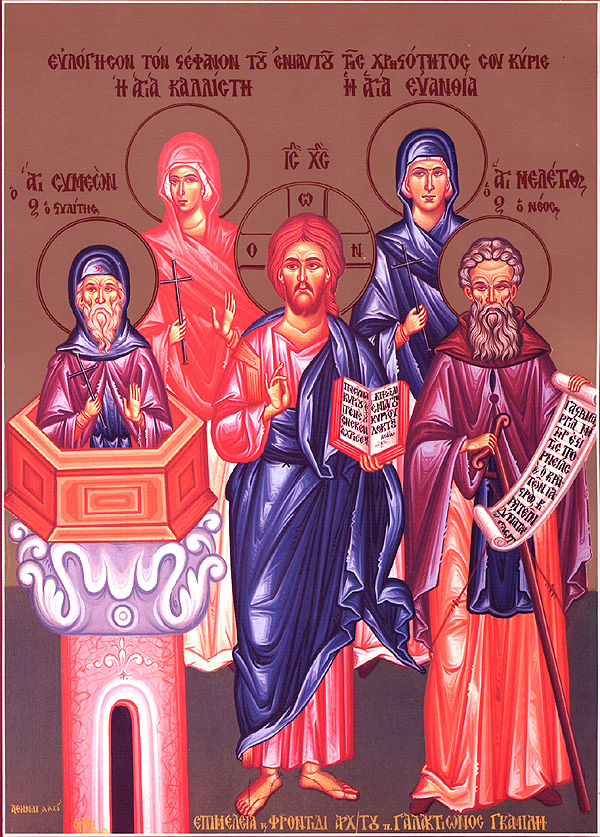 The Holy Martyrs Callista and her brothers Euodos and Hermogenes, Christians of Nikomedia, were brought to trial before the pagan governor for confessing their faith in Christ. Having refused to offer sacrifice to idols, they were cut down by the sword (+ 309). The Holy Martyrs Callista and her brothers Euodos and Hermogenes, Christians of Nikomedia, were brought to trial before the pagan governor for confessing their faith in Christ. Having refused to offer sacrifice to idols, they were cut down by the sword (+ 309).The 40 Holy Virgins and Saint Ammunos the Deacon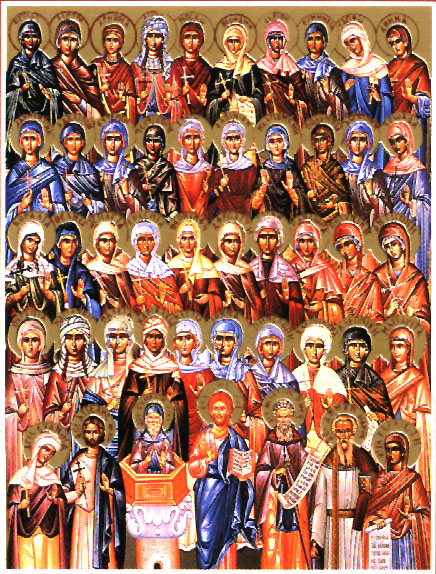 The 40 Holy Virgins and Saint Ammunos the Deacon, who enlightened them with the light of the Christian faith, died as martyrs for Christ under the Roman emperor Licinius at the beginning of the IV Century in the Macedonian city of Adrianopolis. The governor Babdos subjected the holy martyrs to many torments, so as to force them to renounce Christ and worship idols. After cruel tortures they were all sent off to Herakleia to another torturer, before whom also they firmly confessed their faith in Christ and refused to worship idols. By order of the torturer, Saint Ammunos and 8 virgins with him were beheaded, 10 virgins were burnt, six of them died after red-hot iron was put into their mouths, six were stabbed with knives, and the rest were killed with swords. The 40 Holy Virgins and Saint Ammunos the Deacon, who enlightened them with the light of the Christian faith, died as martyrs for Christ under the Roman emperor Licinius at the beginning of the IV Century in the Macedonian city of Adrianopolis. The governor Babdos subjected the holy martyrs to many torments, so as to force them to renounce Christ and worship idols. After cruel tortures they were all sent off to Herakleia to another torturer, before whom also they firmly confessed their faith in Christ and refused to worship idols. By order of the torturer, Saint Ammunos and 8 virgins with him were beheaded, 10 virgins were burnt, six of them died after red-hot iron was put into their mouths, six were stabbed with knives, and the rest were killed with swords. Venerable Meletius the Younger of Thebes (1095-1124)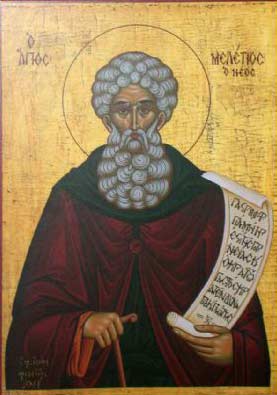 He was born in Cappadocia around 1035. He became a monk in Constantinople, but after a few years he went on pilgrimage to Jerusalem and Rome, then settled at a small monastery near Thebes. Here Meletios became known for his piety: he wore one garment of woven horsehair and, as the Synaxarion says, 'never let his eyelids slumber without having bathed the mat he lay on with his tears... He was born in Cappadocia around 1035. He became a monk in Constantinople, but after a few years he went on pilgrimage to Jerusalem and Rome, then settled at a small monastery near Thebes. Here Meletios became known for his piety: he wore one garment of woven horsehair and, as the Synaxarion says, 'never let his eyelids slumber without having bathed the mat he lay on with his tears...New Martyr Angelis of Constantinople (1680)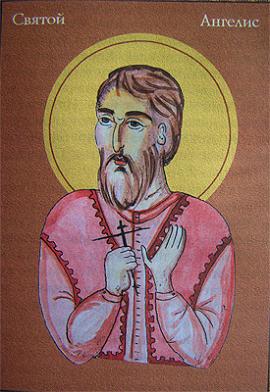 He was a goldsmith living in Constantinople. While he was celebrating the Dormition of the Theotokos with some friends in a nearby village, the party was joined by some Turkish neighbors. The Christians and Turks drank a great amount together, and at one point entertained themselves by exchanging headgear. The next day, when everyone had sobered up, a Turk asked Angelis why he was not wearing a Muslim turban, for wearing it once was a sign of conversion... He was a goldsmith living in Constantinople. While he was celebrating the Dormition of the Theotokos with some friends in a nearby village, the party was joined by some Turkish neighbors. The Christians and Turks drank a great amount together, and at one point entertained themselves by exchanging headgear. The next day, when everyone had sobered up, a Turk asked Angelis why he was not wearing a Muslim turban, for wearing it once was a sign of conversion...St. EvanthiaVenerable Nicholas of Courtaliatis in Crete, monk (1670)Synaxis of the Most Holy Theotokos in Miasena Monastery (864.)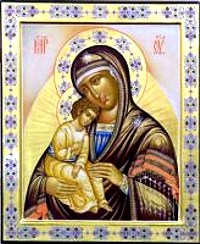 During the persecution of the Emperor Leo the Isaurian against the Holy Icons, the wonderworking image depicting the Synaxis of the Theotokos and found in the Miasini Monastery in Armenia was thrown into Lake Azurov. Within 100 years after the restoration of icon veneration, this holy icon appeared in the year 864 completely unharmed on the surface of the water. The feast is established in memory of this appearance that happened on September 1. During the persecution of the Emperor Leo the Isaurian against the Holy Icons, the wonderworking image depicting the Synaxis of the Theotokos and found in the Miasini Monastery in Armenia was thrown into Lake Azurov. Within 100 years after the restoration of icon veneration, this holy icon appeared in the year 864 completely unharmed on the surface of the water. The feast is established in memory of this appearance that happened on September 1. |